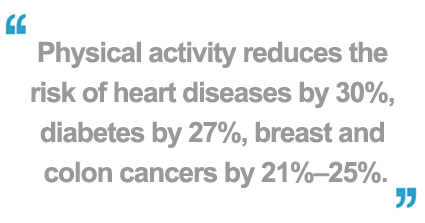Physical inactivity is a key risk factor for noncommunicable diseases, and the fourth leading cause of early death globally. Physical inactivity has reached alarming levels in the Eastern Mediterranean Region, which has the second highest level of physically inactive populations among WHO regions and the highest level for women.
 Increasing levels of activity through sports, recreation, cycling and walking can improve health and lower risk of noncommunicable diseasesRecent estimates show that approximately 31% of the world's population does not undertake the recommended amount of physical activity to protect their health. In the Region, available data from 8 countries show levels of inactivity range from about 30% to as high as 70%. Of concern, less than half of the countries of the Region have systematic monitoring of levels of physical activity in adults and children and very few countries have commenced any comprehensive action aimed at increasing levels of activity through sports, recreation, and cycling and walking.
Increasing levels of activity through sports, recreation, cycling and walking can improve health and lower risk of noncommunicable diseasesRecent estimates show that approximately 31% of the world's population does not undertake the recommended amount of physical activity to protect their health. In the Region, available data from 8 countries show levels of inactivity range from about 30% to as high as 70%. Of concern, less than half of the countries of the Region have systematic monitoring of levels of physical activity in adults and children and very few countries have commenced any comprehensive action aimed at increasing levels of activity through sports, recreation, and cycling and walking.
In 2011, the UN Political Declaration on Prevention and Control of Noncommunicable Diseases, agreed by all Member States, renewed the call on Member States to take actions to reduce physical inactivity.
At the World Health Assembly in May 2013, Member States endorsed the need to implement actions to reach the target of a 10% reduction in physical inactivity by 2025.
Physical activity is fundamental in achieving energy balance and weight control.
Watch the animated infographic on physical activity | Arabic
 Physical activity recommendations
Physical activity recommendations
The "Global Recommendations on Physical Activity for Health" address three age groups: 5–17 years old, 18–64 years old and 65 years old and above. These age groups were selected taking into consideration the nature and availability of the scientific evidence relevant to the prevention of noncommunicable diseases through physical activity.
Recommended levels of physical activity for children aged 5–17 years
Recommended levels of physical activity for adults aged 18–64 years
Recommended levels of physical activity for adults aged 65 and above




